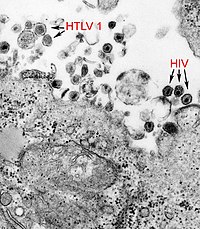
Photo from wikipedia
Background HTLV-1 associated adult T cell leukemia/lymphoma (ATLL) is an aggressive malignant disorder diagnosed in countries endemic with the human T cell lymphotropic virus type-1. It is classified into 4… Click to show full abstract
Background HTLV-1 associated adult T cell leukemia/lymphoma (ATLL) is an aggressive malignant disorder diagnosed in countries endemic with the human T cell lymphotropic virus type-1. It is classified into 4 clinical subtypes based on clinical course: acute, chronic, smoldering and lymphoma. Acute and lymphoma types have the worse prognosis. Intensive chemotherapy regimens and autologous stem cell transplant have failed to improve patient outcomes. Allogeneic hematopoietic cell transplantation is commonly offered as front-line consolidation despite lack of randomized controlled studies. Materials and methods We performed a comprehensive search of the medical literature using PubMed/Medline and EMBASE on September 10, 2018. We extracted data on clinical outcomes related to benefits (complete response (CR), overall [OS] and progression-free [PFS] survival) and harms (relapse and non-relapse mortality [NRM]) independently by two authors. Our search strategy identified a total of 801 references. Twenty-two studies (n=4338 patients) were included in this systematic review; but only 19 (n=2246 patients) in the meta-analysis (Figure 1). Results Reduced intensity regimens were most commonly utilized (52%).Bone marrow was the most common source of hematopoietic stem cells (47%). The pooled CR rates from 7 studies (118 patients) was 75% (95%CI=57-90%) with high heterogeneity (I2=73%). Pooled OS rates (n=18 studies, 2236 patients) after allogeneic HCT was 38% (95%CI=33-44%) but heterogeneity among the included studies was high I2=78% (Figure 2). Pooled PFS rates (n=7 studies, 246 patients) was 37% (95%CI=27-48%) and the heterogeneity among the studies was moderate (I2=59%). Pooled relapse rates from 14 studies (n=834 patients) was 36% (95%CI=29-43%) with high heterogeneity among the included studies (I2=67%). Pooled NRM rates from 16 studies (1960 patients) was 29% (95%CI=23-35%) with high heterogeneity among the studies (I2=81.3%). Conclusions Despite high CR rates following allogeneic HCT, PFS and OS rates are relatively low, mainly due to high relapse rates and high transplant-related mortality. Future studies should evaluate strategies to help reduce relapse and decrease morbidity and mortality associated with treatment.
Journal Title: Biology of Blood and Marrow Transplantation
Year Published: 2019
Link to full text (if available)
Share on Social Media: Sign Up to like & get
recommendations!